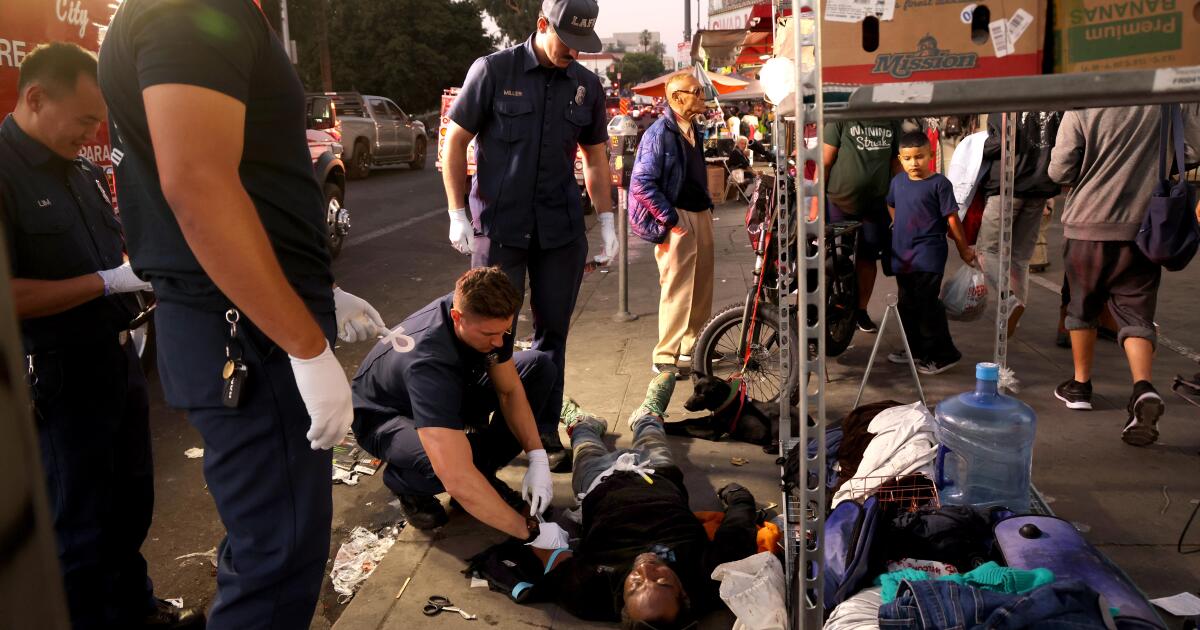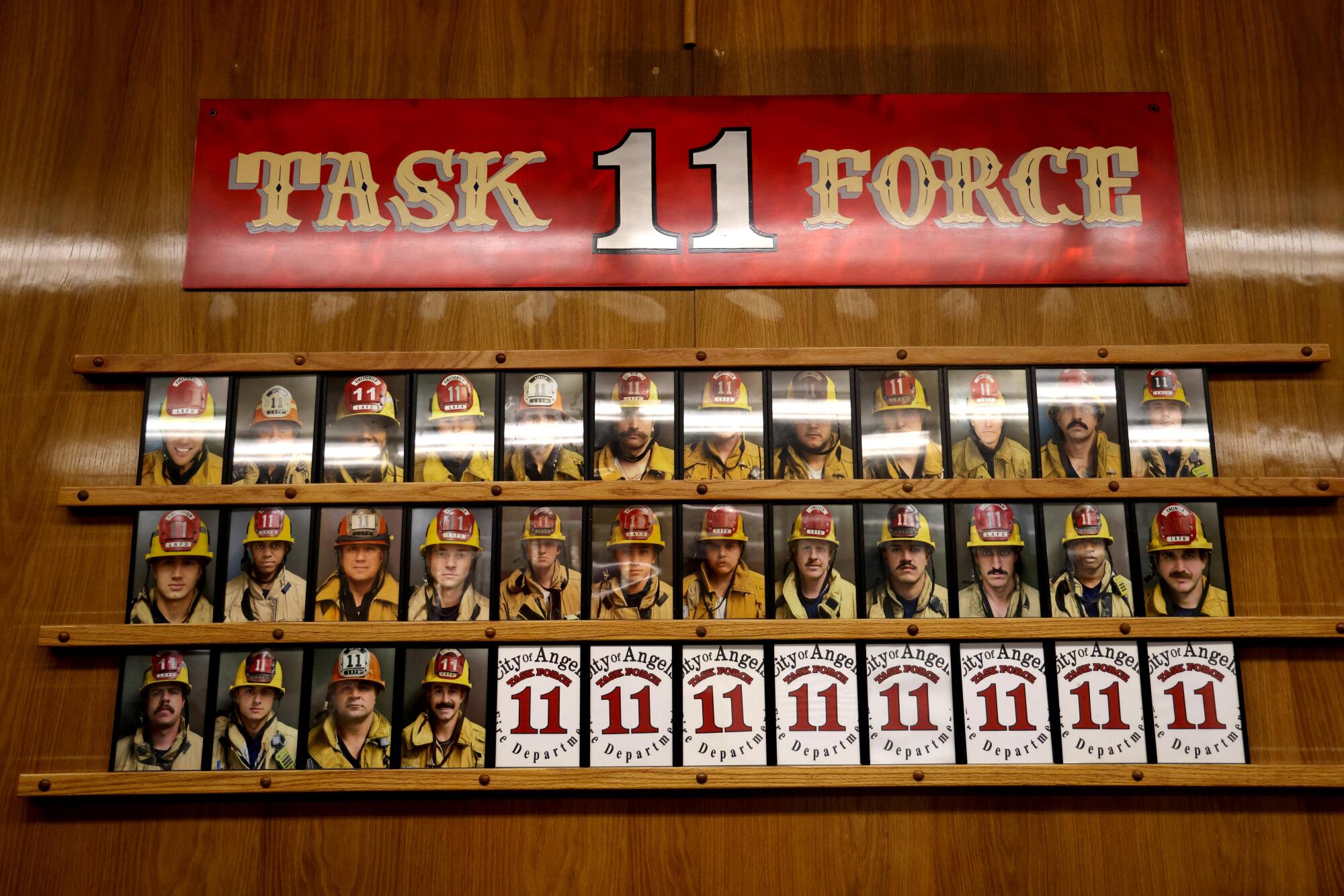Column: At LAFD Station 11, one of the nation’s busiest, fewer fires, but no more drug overdose emergencies

If you spend much time in the Westlake neighborhood of Los Angeles, you’ll notice, amid the bustle of buses and trucks and car horns and vendors selling their wares, an almost constant siren call.
They are screaming day and night in quick response to endless emergencies, many of them in and around MacArthur Park. But it’s usually not fire that LAFD Station 11 responds to. Through August of this year, there were 599 drug use calls, compared to 36 handled by building fires.
“I had three in one day, one person,” said firefighter/first responder Madison Viray, who has worked at Station 11 for nine years.
California is about to be hit by a wave of aging people, and Steve Lopez is riding it. Her column focuses on the blessings and burdens of growing up — and how some people challenge the stigma associated with aging.
That’s one measure of how bad the epidemic is in a low-income neighborhood where homelessness is rampant, drugs are sold and consumed openly, 83 people died due to drug use in 2023, and vendors are complaining about gang threats and drug theft.
In the middle of it all is Station 11, located on 7th Street two blocks from the park, with its trucks rolling by day and night in every direction. Hanging on the wall inside the station is a proclamation by Councilor Eunisses Hernandez and his colleagues honoring the employees by being ranked by Firehouse Magazine as the busiest company in the nation in 2022.
This year, Station 11 is behind Station 9 on Skid Row (home to one of the city’s biggest drug dens) for total, but will match last year’s tally of 15,262 calls for fire and medical incidents (most of them not including overdoses).

As I met with several members of the crew at Station 11 on Wednesday afternoon, Viray and engineer Cody Eitner suddenly left to answer a call from the area near 6th Street and Burlington Avenue. They returned after a while to say that they were too late to rescue the deceased.
“Someone found him and called, but they were gone for a long time and there was nothing we could do,” said Eitner.
Word on the street is that drugs in the neighborhood are dirty. Cocaine may be laced with fentanyl, and fentanyl may be mixed with the animal tranquilizer Xylazine, or “tranq”—all of which raise the possibility of an adverse reaction.
It is not uncommon to see people in the park with multiple blisters on their arms and legs – one of the side effects of tranq. And it’s not uncommon to see people bent in half, like twisted statues, because of the thickening of the muscles that firefighters refer to as the “Fentanyl fold.”

“Most of the time they are very grateful for saving their lives,” said Cody Eitner about people who have recovered from drug addiction.
Trooper Brian Franco, who started working at Station 11 two decades ago as a firefighter, said, “We’ve seen more people die from drug overdoses than we did from heroin.”
However with fentanyl, the drug naloxone, if administered quickly enough, can reverse the effects of opiates and save lives. Sometimes it is used by friends of the victim, or the MacArthur Park overdose response team that was recently started by Councilor Hernandez and the LA County Department of Public Health. Or by the staff of Station 11.
“Most of us [overdose] the calls are now fentanyl,” said Capt. Adam VanGerpen, who works as a public information officer but also runs. “If we see that there is shallow breathing … then we will open their eyes and see if their pupils are straight. Now we know it’s probably not … cardiac arrest or … respiratory arrest. Now we think, OK, this is extreme. “
It can be easier to treat a fentanyl case than a PCP or meth overdose, VanGerpen said, because the latter two drugs can make a person angry and combative. If it’s a fentanyl overdose, responders will use naloxone as a nasal spray (Narcan), inject it into a muscle, or pump it through an IV, depending on the situation.
“Anytime we win, it’s satisfying,” said Captain Adam Brandos. “In a station like this, where we make as many calls as we do, and it’s a boring process, that little win is really good for morale. But it is not so satisfying to see a replay. And we don’t change the cycle at all. … It keeps repeating over and over.”

Sometimes, Brandos said, one answer can create a buzz: “We might go to one phone in the park and that phone turns into four, because … the pool, and then someone else is here.” So that’s normal.”
What’s most impressive about it all, says Brandos, is that these scenes play out so often that they’ve become familiar.
When you begin to lay eyes on the depth of social decay and social depression, it is shocking. But it’s all there again the next day, and the next, and although the shock continues, a little numbness takes over, and the doubt that anyone in power is up to the task of restoring any order to order.
Anthony Temple, a paramedic at Station 11, took me on a dark tour of a typical day, starting at the Westlake/MacArthur Park Metro Station, which has doubled in recent years as an underground hall of horrors:

Captain Adam VanGerpen watches as a fire truck is deployed from Station 11.
“People overdosed … in a subway station when people got off the train,” Temple said. “You have people who keep roaming around, we all went down there and did what we had to do, took them to the hospital and left. And you go back to the station and you are sent to another overdose where the person will be down, on the side of the road, like hanging on the road. …
“It’s just during the day, in the morning, during the day, at night, on the side of the road, the platform, the stairs, the park,” said Thembi. “You know, it’s just like everywhere else.”
Two members of this team, Viray and Brandos, said they brought their children to the neighborhood to show them where Father works, and to show them a world they had never imagined.
And the reaction?
“Terrified,” Viray said of his 14-year-old son and 8-year-old daughter.

Emergency medical technicians and paramedics with Los Angeles Fire Station 11 are monitoring a man they revived for an overdose.
“I wanted to show them what decision-making can look like,” said Brandos, who has 9- and 11-year-old girls. … I told them exactly what was going on.”
The staff told me that they share a camaraderie that fits exactly the needs of Station 11. If you choose to work there, it’s because you like to stay busy, you’re proud of the amount of running, and you’re learning to accept that you’re not. create a problem and you can’t fix it. You can only answer it, one call at a time.
Just before 6:30 p.m., the phone rang. A middle-aged man was on the ground at Alvarado Street and Wilshire Boulevard, across the street from the park, possibly going into cardiac arrest from drinking too much. A truck and an ambulance rolled over, lights flashed, sirens blared. They were on the scene in less than three minutes.
The subject was on the floor in front of Yoshinoya Japanese Kitchen, which is bordered by vendors selling electronics, clothing and toiletries. Some of them were blocking the sun, while people were still gathered behind the restaurant in the corridor that serves as a drug store. It’s a hellscape that has become part of the landscape, like palm trees towering over Alvarado Street and dead streetlights.
One salesman went about his business as if he had seen this scene play out so many times that he didn’t need to look again. Some passers-by paused to watch the commotion, perhaps waiting to see if the unconscious man would make it. A boy of ten or so moved closer to watch as three firefighters approached the man.
The wind was full of the heated energy of the day and wasted opportunities, and in the place where I stood behind the ambulance, the garbage was blown six meters into the road on the edge of the road. A bag of chips. Yoshinoya takeout bag. Cans of cocoa. Empty food containers.
All of this is the familiar reality of a neighborhood that once stood as a jewel of the city, and now suffers from waiting for someone, anyone, to stand up and say this shouldn’t exist, it won’t exist, and it needs to end, because of it. with good behavior and benefiting the working people who make up the majority of the residents here, raising children who deserve better.

Emergency medical technicians (EMTs) and paramedics with Los Angeles Fire Station 11 are ready to take a man, recently rehabilitated from drug addiction, to the hospital on the corner of S. Alvarado and Wilshire Blvd.
Firefighter/paramedic Luke Winfield donned white latex gloves and administered a nalaxone IV, tied a blue tourniquet around the man’s upper arm and applied life-saving medication to his elbow.
Seconds later, the man jumped as if on springs, coming back from the brink of death. He asked what happened.
“He drank too much,” said one of the firefighters.
Shaking, she fell into the shopping cart and lay on her back, looking up at the reborn sky as it faded to pink. He would do it. At this time. They put him in an ambulance to go to the hospital.
I asked Winfield, in his two years at Station 11, how many times he had done what he just did.
“Hundreds,” he said. “This place is crazy.”
Source link

